
Folds of velvet, John Day Fossil Beds National Monument / Rebecca Latson
I love every single park unit I have ever visited within the National Park System. That said, while every park unit yields great images, I do believe there are park standouts for particular subjects. So, from all the parks I’ve visited, I began making a list of which parks are my personal favorites for certain photographic categories. As the list grew, I realized I had enough material for a couple of Traveler articles, the first of which you see here.
Favorite Parks for Colorful Imagery
For this category, I’m not referring to favorite parks I’ve visited for autumn color, but rather park units that are notable for their colorful landscapes.
John Day Fossil Beds National Monument (Oregon)
This national monument is one of my favorites for the amazing landscape colors on display. This is not a large park; as a matter of fact, it’s comprised of three small separate units, each about an hour’s drive from the other. Of those three units, two are especially colorful.

Late afternoon sunlight over the Painted Hills Unit, John Day Fossil Beds National Monument / Rebecca Latson
The Painted Hills Unit encompasses a phenomenal vista of rolling, velvety hills layered with maroon and yellow-green crumbly soils indicating past climate changes. Depending upon what type of light the day provides, the maroon may turn into a bright, dark, almost blood-red, and the yellow-green becomes a brilliant gold. While you can stand anywhere in this unit to capture colorful images, I think the best photo ops are centered around the Painted Hills Overlook.

Green claystones at the Foree area of the Sheep Rock Unit, John Day Fossil Beds National Monument / Rebecca Latson
At the Sheep Rock Unit, your eyes (and camera lens) will feast upon vistas of steep, crumbly hills and cliffs composed of blue-green claystone, a fine-grained sedimentary rock colored by the mineral celadonite (derived from the French word céladon, meaning “sea-green”). For close views of this green rockery, park your vehicle in the Foree area of the Sheep Rock Unit and hike both Flood of Fire and Story in Stone trails.
Petrified Forest National Park (Arizona)
Here’s another park with a “painted” landscape. The hills and dunes in the Painted Desert display varying bright shades of yellow, red, and orange. Located at the north entrance to the park just off Interstate 40, there are a number of overlooks providing wide-open views of this colorful Painted Desert scenery perfect for both wide-angle and telephoto shots.

Storm clouds over the Painted Desert, Petrified Forest National Park / Rebecca Latson
If your eyes tire of seeing all those bright warm colors, drive south to the Blue Mesa trailhead for a short hike down into the park’s badlands. The crumbly, rounded hills and mesas are layered with cool tones of blue and purple alternating with cream-colored soils.
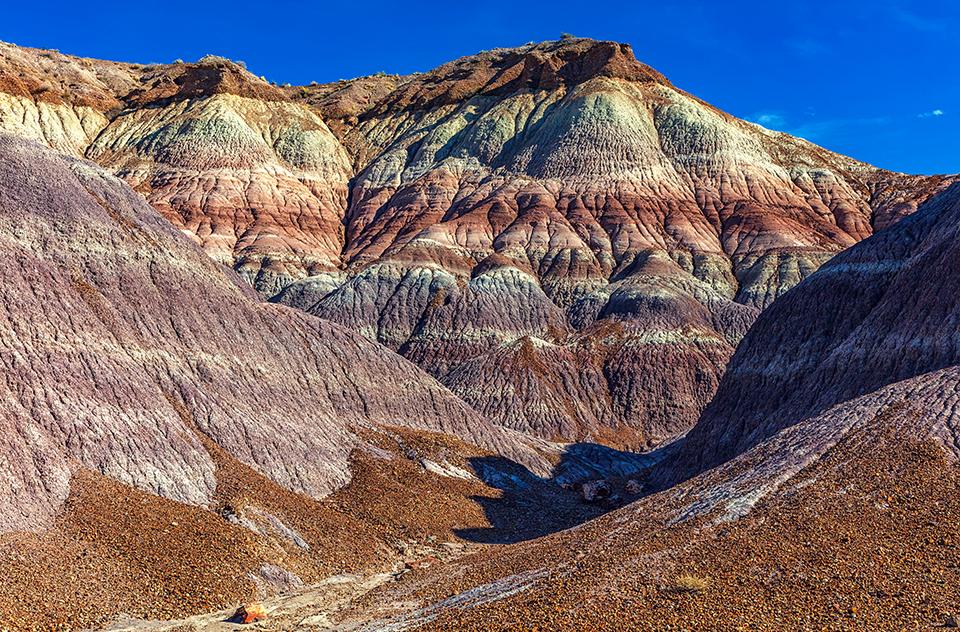
Colorful scenery along the Blue Mesa Trail, Petrified Forest National Park / Rebecca Latson
Keep your eyes peeled for sections of petrified wood scattered throughout the landscape. Use your SLR’s telephoto lens or your point-and-shoot’s / smartphone’s telephoto setting to get a close-up view of the silica colored by manganese, hematite, pyrite, iron, and goethite that replaced the original wood organic matter.

Petrified logs along the Crystal Forest Trail, Petrified Forest National Park / Rebecca Latson

The many colors of petrified wood, Petrified Forest National Park / Rebecca Latson
Grand Canyon National Park (Arizona)
Did your first glimpse of this national park leave you speechless (ok, aside from the oooos and ahhhs)? Sunrise and sunset especially bring out the vivid gold, rust red, purple, and mauve within the rock layers of this canyon land. As you wander the trails, you and your camera will be treated to colorful rock strata seen from canyon top to bottom at both North and South Rims.

A late-afternoon view along the South Rim, Grand Canyon National Park / Rebecca Latson

A North Rim Sunrise, Grand Canyon National Park / Rebecca Latson
Favorite Parks for Mountain Landscapes
I’m a mountain gal. I was born in Montana and the love of the mountains never left me, even after spending much of my life east of the Rio Grande. In truth, any national park unit with mountains is beautiful to me, but of those mountainous parks visited, I do have my favorites.
Glacier National Park (Montana)
This “Crown of the Continent” boasts a scenic, high-altitude road through rugged mountains carved by glaciers, cut by streams and waterfalls, and carpeted with wildflowers and deep green forests. Glacier National Park was the first park unit I ever visited when I was a little girl living roughly 20 miles away from the West Glacier entrance. A park like Glacier remains in heart and memory no matter where you ultimately end up living.

The view along the Grinnell Glacier Trail, Many Glacier area, Glacier National Park / Rebecca Latson
Mount Rainier National Park (Washington)
Composite volcano Mount Rainier is one heck of a mountain backdrop, surrounded by other mountains like the Tatoosh range, and looming high and glaciated over a landscape of wildflowers, lakes, rivers, and forests. Anyplace you wander within this national park provides great photo ops.
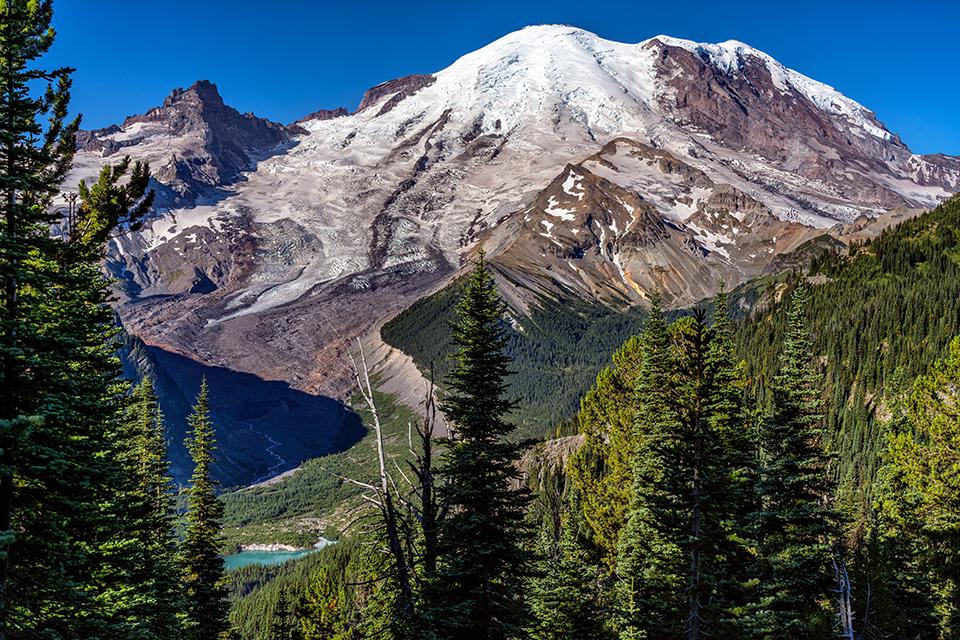
Mount Rainier landscape, Mount Rainier National Park / Rebecca Latson
Denali National Park and Preserve (Alaska)
Even if you are not among the 30 percent of visitors to actually get a clear view of Denali Mountain, there are still craggy and colorful mountain ranges at which to point your camera. The Alaska Range provides a sharp, toothy jawbone to the back molar of Denali, and the Polychrome Mountains offer splashes of high-altitude color.

Denali in the morning, Denali National Park and Preserve / Rebecca Latson

Sunlight and cloud shadows along Polychrome Pass, Denali National Park and Preserve / Rebecca Latson
Favorite Parks for Sunrises / Sunsets
While sunrise and sunset shots are stupendous at any park, the following units are my favorites, and considering the number of parks listed for this category, I guess you could say that sunrise and sunset shots are also my favorite photographic subjects. Oh, and while I think of it: whatever park unit you visit for Golden Hour (sunrise or sunset) photography, do remember to take note of the sun’s angle during your stay. Depending upon the time of year you travel to a park, the sun may not rise or set at exactly the same spot, which might make or break that special shot you want at an iconic location.
Crater Lake National Park (Oregon)
All or a portion of Crater Lake in your sunrise/sunset compositions is like the cherry on top of a yummy ice cream sundae. During my July visit, my two favorite sunrise spots were the Watchman Overlook and Sinnott Memorial Overlook.

Sunrise at the Watchman Overlook, Crater Lake National Park / Rebecca Latson
For a summer sunset, the view was lovely from Palisade Point Overlook.

A sunset view from Palisade Point, Crater Lake National Park / Rebecca Latson
Mount Rainier National Park (Washington)
Oh, you noticed I’ve already listed this park as a favorite for a different category? Well, some parks are favorites of mine for a number of different categories, and Mount Rainier just happens to be one of those parks. You see, sunrise at Tipsoo Lake is fantastic. Sunrise at the Sunrise area is also fantastic. Sunrise at Reflection Lakes is also fantastic. Sunrise at the Paradise area is also fantastic. Sunrise is …. well, you get my drift.
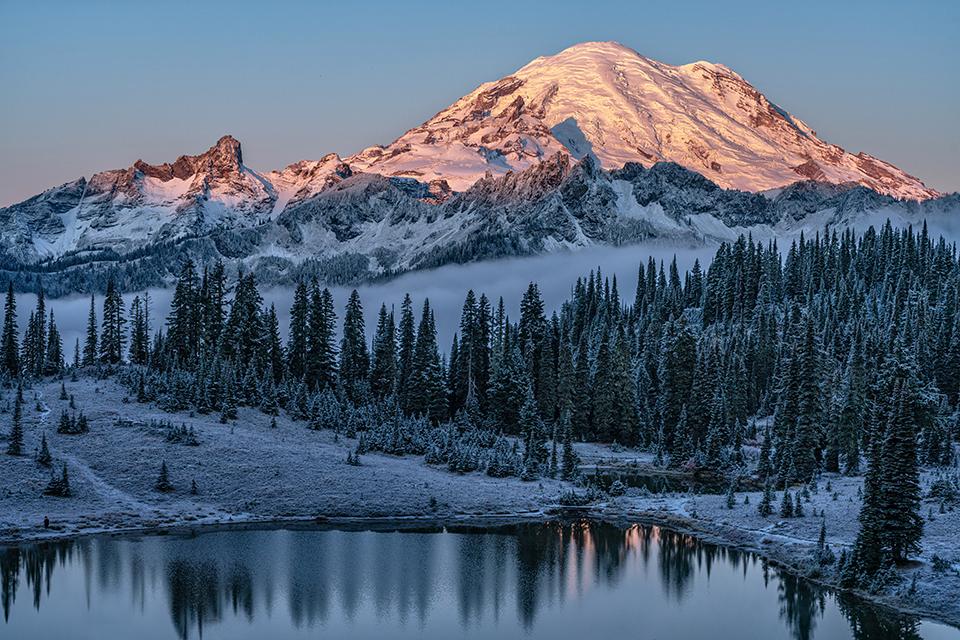
A frosty autumn sunrise over Tipsoo Lake and "The Mountain," Mount Rainier National Park / Rebecca Latson

Sunrise at the Sunrise area (yes, the sunrise is that saturated, but only for a few minutes), Mount Rainier National Park / Rebecca Latson
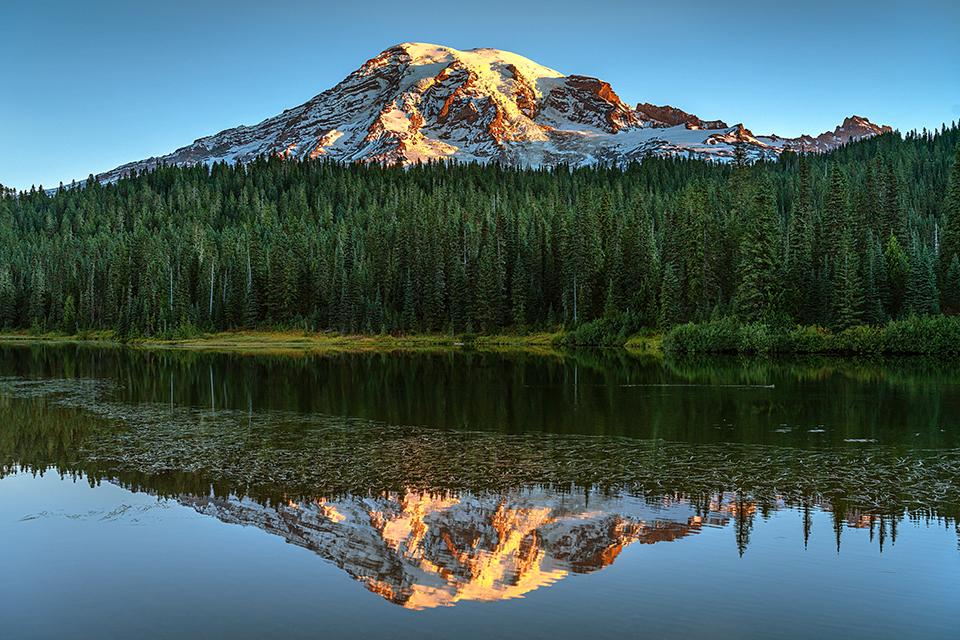
Sunrise over Reflection Lakes, Mount Rainier National Park / Rebecca Latson
Bryce Canyon National Park (Utah)
Anywhere you want to set up shop for a sunrise shot will be the perfect location, whether it’s at Sunrise Point, Sunset Point, Inspiration Point, down along the trail with Thor’s Hammer in the background, or on the Rim Trail between any of those locations. And, if you happen to turn your camera away from the rising sun and point it toward the surreal hoodoos within the park’s natural amphitheaters, you’ll be treated to a blazing concert of deeply-saturated oranges, golds, and pinks. Bryce Canyon knows how to throw a great sunrise party.

Sunrise at Sunrise Point, Bryce Canyon National Park / Rebecca Latson

Sunrise over Bryce Amphitheater, Bryce Canyon National Park / Rebecca Latson
Glacier National Park (Montana)
Sunset at Lake McDonald near the West Glacier entrance and sunrise at the Wild Goose Island view area are two favorite places yielding awesome, sometimes dramatic, compositions. Sunrise over Swiftcurrent Lake in the Many Glacier area of this park is also pretty special.

A winter sunset over Lake McDonald, Glacier National Park / Rebecca Latson

Storm clouds and a swath of autumn sunrise at St. Mary Lake, Glacier National Park / Rebecca Latson

Sunrise and moonset over Swiftcurrent Lake in the Many Glacier area, Glacier National Park / Rebecca Latson
Olympic National Park (Washington)
There’s something about the brilliant simplicity of an ocean sunset, isn’t there? I captured many Pacific Coast sunsets during my winter and summer stays at this national park.
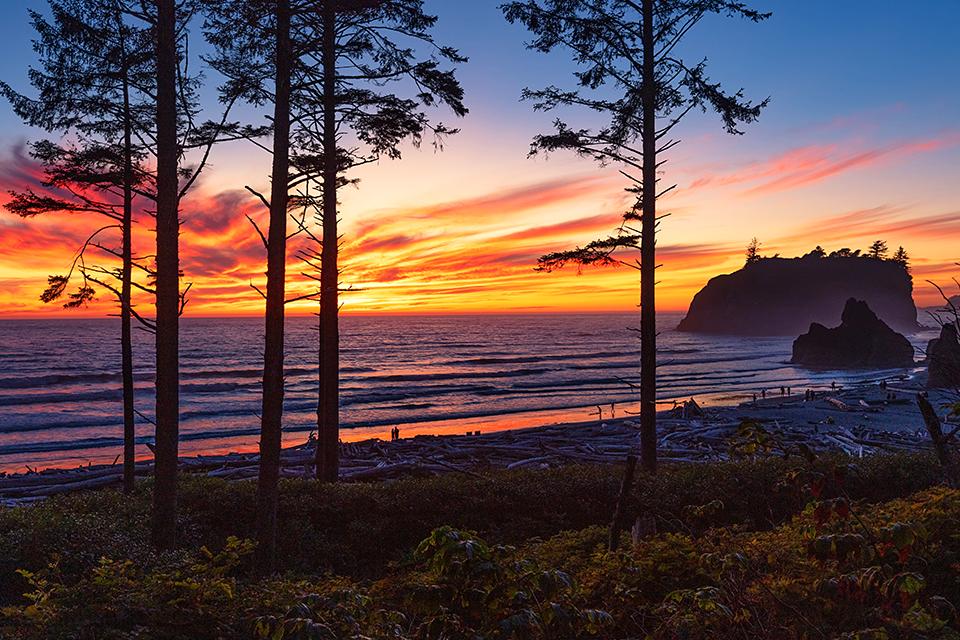
Sunset's afterglow at Ruby Beach, Olympic National Park / Rebecca Latson

A Kalaloch Beach sunset, Olympic National Park / Rebecca Latson
Padre Island National Seashore (Texas)
Just as with sunsets, sunrises over a large body of water (like the Gulf of Mexico) are fantastic, and this national seashore provided me ample opportunity for beautiful morning shots over the course of two different visits.

Sunrise at Malaquite Beach, Padre Island National Seashore / Rebecca Latson

Sunrise at the beach, Padre Island National Seashore / Rebecca Latson
Favorite Parks for Night Photography
“Half the park is after dark,” according to the National Park Service. I totally concur, except that as I grow older, I find it more difficult to stay up late enough (I am not a night owl). When I am out in the dark with my camera and tripod, I can tell you it’s one neat experience. After your eyes become accustomed to the inky night lit only by those pinpoints of light, you’ll begin to notice other things, like the “sound” of silence. It’s profound … until it is broken by the yip, yip, yipping of a coyote, or the hollow hooting of an owl somewhere in the distance, or the burbling flow of a nearby stream, or the rustle of bushes nearby that might make you a little – um - nervous.
Mount Rainier National Park (Washington)

Pre-dawn stars at Reflection Lakes, Mount Rainier National Park / Rebecca Latson
Reflection Lakes is awesome for night photography. Even if you are arriving before the dawn breaks, you can still capture amazing star shots in the sky that are also reflected in the lake water, with Mount Rainier towering over the composition.

A busy summer night at the Sunrise area, Mount Rainier National Park / Rebecca Latson
The Sunrise area is a great place for night photography with the proviso that you might also capture “civilization” in your star imagery, depending upon where you set your tripod. While some photographers (probably most photographers) may not be so enamored, I thought night photography at the Sunrise area was lovely and interesting, with the Milky Way looming over “The Mountain,” light streams of hikers moving along the trail below, and evidence of an often-busy summer night as seen from the Sunrise visitor parking lot.
Big Bend National Park (Texas)
The silence is complete in this national park, perhaps momentarily broken by the cry of a lone coyote before returning to that nighttime hush. And the stars. Oh my. Because this national park is located in the Middle of Nowhere, Texas, there is no light pollution to mar the clear night sky studded with thousands of glittery stars.

The road to the stars, Big Bend National Park / Rebecca Latson
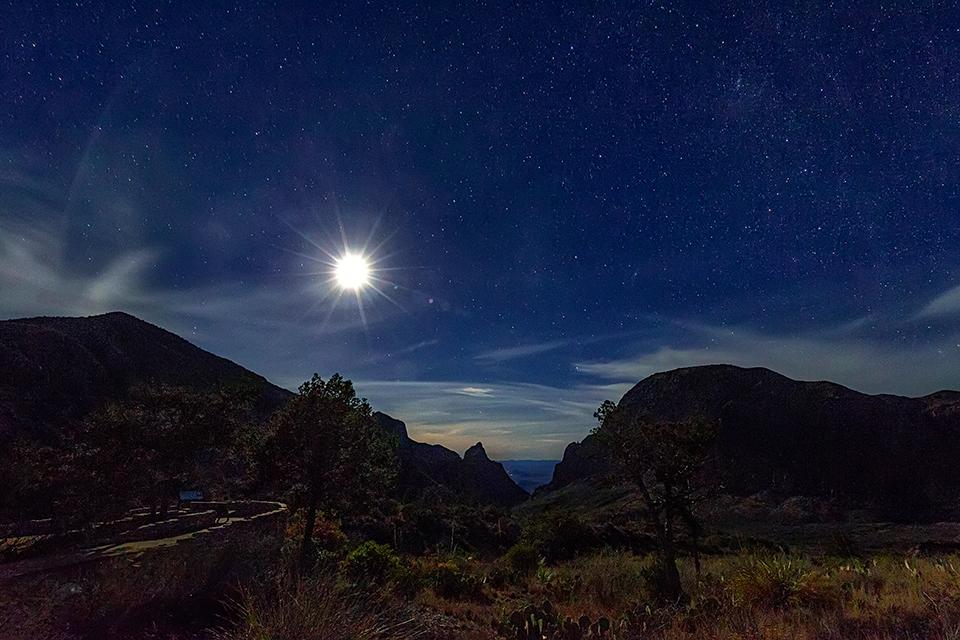
Moonlight over the Window view area, Big Bend National Park / Rebecca Latson
Favorite Parks for Wildlife Photography
While I do not specifically concentrate on wildlife like so many other photographers do (Bridger Peaks Photography, Max Waugh, Tin Man Lee, Deby Dixon), I can still capture a pretty nice composition of a bear, moose, or other wildlife, and you can too, at these park favorites of mine.
Katmai National Park and Preserve / Lake Clark National Park and Preserve (Alaska)
It was a tough choice between Katmai and Lake Clark ... so I chose both. These two park units, located in Alaska, are fantastic for brown bear photography. I saw more interaction among the bears at Katmai, but I had more opportunity for mom & baby shots at Lake Clark.

Hey! This spot is mine! Nope! It's mine! Katmai National Park and Preserve / Rebecca Latson

Got milk? Lake Clark National Park and Preserve / Rebecca Latson
Glacier National Park (Montana)
Moose is the word and Fishercap Lake is the place for photographing these large ungulates at Glacier. When I first started hiking to this lake, I figured moose were out only during the morning hours. Later hikes proved me wrong. I saw moose in the lake at all hours of the day, and you might too.

Moose in Fishercap Lake, Many Glacier area, Glacier National Park / Rebecca Latson
Yellowstone National Park (Montana, Idaho, Wyoming)
This park unit isn’t called the “American Serengeti” for nothin’. I didn’t set out to photograph the wildlife per se, but if the opportunity was proffered, I took it. And the opportunity offered itself quite a bit.

Wolf on the road, Yellowstone National Park / Rebecca Latson

Coyote on the hillside at Upper Geyser Basin, Yellowstone National Park / Rebecca Latson

Bison in the snow, Yellowstone National Park / Rebecca Latson

Elk at Mammoth Hot Springs, Yellowstone National Park / Rebecca Latson
Whew! I’m going to stop for now, before your eyes glaze over, and save back some of these park category favorites for next month’s column. Maybe some of these favorites for specific categories are already your favorites, or maybe they will convince you to travel and photograph in these spots and become new favorites. Stay tuned for next month’s continuation of favorite parks for certain photography.



Comments
Once again, thank you for sharing your spectacular photos!!
Thanks for your kind words, Bill. What are your favorite parks?
Great choices. I'd add Theodore Roosevelt N.P. for wildlife and Shenendoah N.P. for sunrise and sunset.
Rebecca...my favorite 3 are Glacier (religious experience), Yosemite, and Bryce Canyon. On second thought, my favorites are all 31 National Parks I have visited. Thanks for asking. Please keep your camera busy.
Beauty in so many ways in so many places. Amplified at sunrise & sunset as Ansel said.